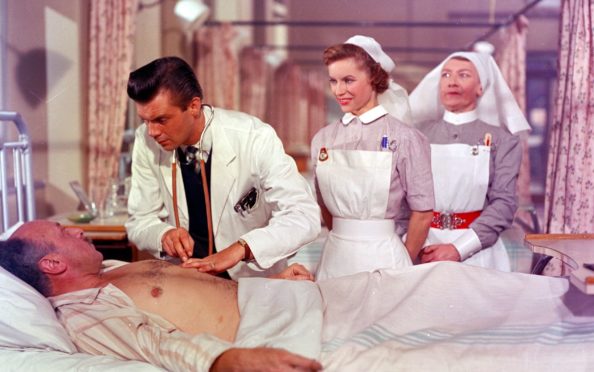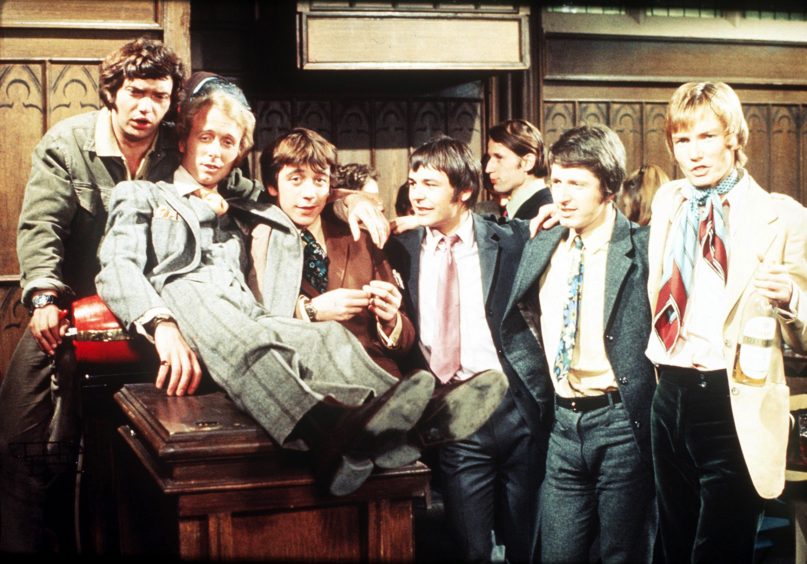
When author Richard Gordon ran off to sea in the early 1950s, little did he know that endless days of boredom would trigger the writing of his classic novel, Doctor In The House.
And it didn’t stop there because the doctor-turned-writer penned 14 sequels in the Doctor series, many of which were adapted for the big screen, a long-running TV show and popular radio comedy.
Gordon – who died in 2017, aged 96 – experienced his stint at sea as a ship’s doctor in the Merchant Navy.
Travelling in cargo ships around the world, he soon discovered he had plenty of time on his hands.
“Life was pretty luxurious at first, what with the gold braids on my cuff and plenty of gin at hand,” Gordon once told me.
“But as there were only 12 other crew members, all of whom were rarely ill, life on the ocean waves became monotonous, with most days consisting of drinking with the chief engineer.”
To avoid an early encounter with cirrhosis of the liver, Gordon sat down to write Doctor In The House, based on his own adventures as a callow medical student.
Shortly after his return from travelling the globe, he started on the follow-up, Doctor At Sea.
Soon, his early literary successes transferred to the big screen, projecting Richard Gordon into the film world, mixing with the likes of producer Betty Box, director Ralph Thomas and a host of stalwarts from the British film industry. There were even small parts for Gordon, whose medical career had included being resident anaesthetist at St Bartholomew’s Hospital, London.
“I used to perform in all the hospital plays so asked Ralph Thomas for a part in Doctor In The House. Not surprisingly, he gave me a small role as an anaesthetist – it was great fun.”
The hilarious encounters of Simon Sparrow, played by Dirk Bogarde in the movie, and the rest of the well-matured students of St Swithin’s, were well received by the industry and public alike.
In fact, Doctor In The House was crowned the most popular box-office film of 1954. Watched by a third of the British population, it reportedly became the most successful movie in the Rank Organisation’s history.
Remarkably, some film companies rejected the rights before prolific producer Betty Box, who had a penchant for making successful comedies, snapped them up.
It was during an arduous train trip back to London that she whiled away the time reading a novel – Gordon’s Doctor In The House, to be precise.
It wasn’t long before she realised the story had all the ingredients needed for a successful comedy film, as she explained in her autobiography, published in 2000.
“I was enjoying reading Doctor In The House so much I didn’t realise, until I got to the last page and the train was pulling in to London, that my laughter had almost emptied the carriage.”
Soon after closing the book, she started missing the loveable characters brought to life so vividly in Richard Gordon’s novel.
While many of her contemporaries didn’t share her enthusiasm at first, Betty Box – who was married to Carry On producer Peter Rogers – knew the story had everything needed for a “happy, contemporary comedy, just the type of movie the public wanted”.
And how right she was. Director Ralph Thomas once explained why he felt the movie was such a great success. He said: “People liked and identified with the funny situations they had seen happen or which had happened to themselves as patients, doctors or nurses.”
The cast included James Robertson Justice (irascible chief surgeon, Sir Lancelot Spratt), Muriel Pavlow (Joy, a sweet-natured nurse) and Donald Sinden, Kenneth More and Donald Houston (medical students Tony Benskin, Richard Grimsdyke and Taffy Evans respectively).
Joining them at St Swithin’s Hospital as a fellow medical student was Dirk Bogarde, who played Simon Sparrow. The role helped propel Bogarde’s film career, establishing him as one of Britain’s biggest stars of the 1950s.
Because Bogarde hadn’t appeared in a comedy before, not everyone at Rank agreed that he was right to play Sparrow. However, Box stuck to her guns and offered him the role.
Despite Bogarde regarding the part as lightweight, he accepted and became the film company’s hottest star in the process.
Doctor In The House spotlighted the successes and failures of a group of students studying at medical school and was based on author Richard Gordon’s own adventures.
Kenneth More knew as soon as he read the script that it was right for him. Reflecting on the film’s tremendous success, he once stated: “It broke all attendance records in London and was eventually seen by 15 million cinemagoers in Britain alone. When it was first shown in America, the audience stood up and clapped.”
The actor – who died in 1982, aged 67 – had happy memories of the picture and became the recipient of wonderful news not long after the film’s release.
He said: “I was playing golf shortly after its première when I had a message from the clubhouse that my wife wanted to speak to me urgently.”
His excited wife told him that the British Film Academy had awarded him the Best British Actor Award for 1955.
He added: “I was so astonished and elated that for the rest of the round I could hardly see the ball, let alone hit it!”
The film’s runaway success surprised many in the industry.
“Apparently, at that time films about doctors were thought to be death at the box office so none of the original publicity photographs showed us in white coats – we all had to wear sports jackets,” recalled the late Donald Sinden.
“They even thought of changing the title.”
Rank’s lack of enthusiasm for the project also explains why it was allocated a meagre budget of around £100,000 while actors already contracted to the company filled the roles.
But the film’s instant success soon had officials wanting more. For the next instalment in the series, the cast and crew were soon enjoying life on the ocean wave.
Doctor At Sea focused on the tales of a ship’s doc and involved filming on a Greek liner sailing around the Mediterranean. From the original film’s main cast, only Bogarde and Robertson Justice were retained. The film also featured a young Brigitte Bardot making her British film debut.
Just like the earlier movie, Doctor At Sea was enjoyed by millions of cinemagoers, resulting in it becoming the third most popular movie on the British circuit during 1955.
The late Richard Gordon’s medical-based novels not only transferred successfully to the cinemas, they were adapted for TV, radio and a one-off BBC play starring Brian Rix.
But in terms of the small screen, nothing eclipsed London Weekend Television’s hospital sitcom which squeezed into the TV schedules during July 1969.
Starring Barry Evans, Robin Nedwell, Geoffrey Davies and George Layton as young doctors working at the teaching hospital, St Swithin’s, the storylines were only loosely connected to Gordon’s popular novels.
With scripts from the likes of Graeme Garden, Bill Oddie, Graham Chapman and Barry Cryer, two series of Doctor In The House were screened while follow-up series, including Doctor At Large, Doctor In Charge, Doctor At Sea and Doctor On The Go, continued the momentum.
Writer/actor George Layton, who played Dr Collier, was tipped off about the new series by Christopher Timothy, alias James Herriot in All Creatures Great And Small.
Layton was lucky enough to secure an interview and became the last person the director saw.
“The part I was reading for had already been cast,” Layton told me.
“Luckily, though, they changed their minds and offered the part of Dr Collier to me, although he was initially going to be called Dr Garston.”
Layton – who subsequently wrote many of the episodes with writing partner Jonathan Lynn – regarded the series as a big turning point in his career.
It’s hard to believe that nearly seven decades have passed since the gentle comedy, Doctor In The House, first graced the big screen. Yet, the film’s occasional outings in the TV schedules, along with others in the series, always receives a warm welcome.

Enjoy the convenience of having The Sunday Post delivered as a digital ePaper straight to your smartphone, tablet or computer.
Subscribe for only £5.49 a month and enjoy all the benefits of the printed paper as a digital replica.
Subscribe © ITV/Shutterstock
© ITV/Shutterstock